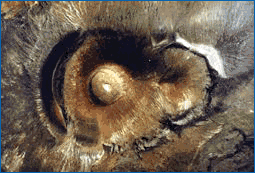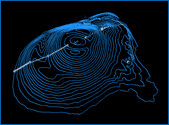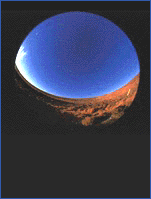
Organized as a distinct set of changing
experiences of light, Turrell's intervention in the natural form of the
Roden Crater will consist of a series of chambers, pathways, tunnels,
and openings onto the sky from within and around the crater's surface.
The artist's subtle refinement of the
natural shape of the crater bowl held 400 feet above the horizon will
alter the viewer's perception of the sky.

Like ancient naked-eye observatories from Newgrange
to Abu Simbal, certain chambers within the crater will allow us to see
and measure the passage of the time through the movement of stars and
planets.
Other spaces will reveal the more
subjective nature of our human relationship to time, light, and space-the
pyrotechnics of sunrise or sunset or the sensation of light as a material
substance.
 Turrell acknowledges both ancient and modern traditions of
art in the landscape, and will create a work of art inseparable from
the land and sky from which it is made. Located on land on a working
cattle ranch bordered by Native American, Western, ancient and contemporary
cultures, Roden Crater is deeply connected to its Arizona landscape
and real-world issues, to a degree unequaled by any other work of art.
Turrell acknowledges both ancient and modern traditions of
art in the landscape, and will create a work of art inseparable from
the land and sky from which it is made. Located on land on a working
cattle ranch bordered by Native American, Western, ancient and contemporary
cultures, Roden Crater is deeply connected to its Arizona landscape
and real-world issues, to a degree unequaled by any other work of art.
Monumental in scale and conception, Turrell's
Roden Crater is not a monument in any traditional sense. It does not
commemorate historical facts or achievements nor is its exterior form
even distinct from its natural surroundings. Rather, harnessing the
drama of light, landscape, and celestial events; disturbing and awakening
our subjective understanding of the universe, Turrell's crater is a
monument to human perception itself-without which cultural history or
achievement would be impossible.
|



